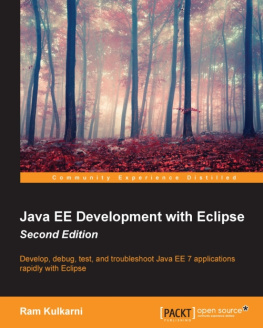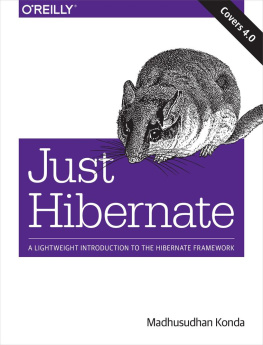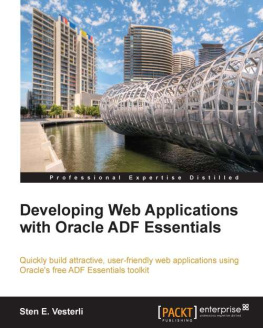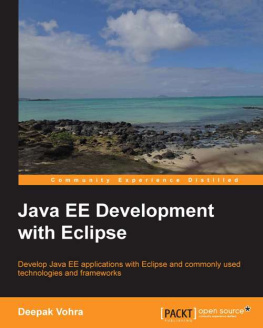Javier Paniza - Rapid Java Web Development
Here you can read online Javier Paniza - Rapid Java Web Development full text of the book (entire story) in english for free. Download pdf and epub, get meaning, cover and reviews about this ebook. year: 2011, publisher: Smashwords Edition, genre: Computer. Description of the work, (preface) as well as reviews are available. Best literature library LitArk.com created for fans of good reading and offers a wide selection of genres:
Romance novel
Science fiction
Adventure
Detective
Science
History
Home and family
Prose
Art
Politics
Computer
Non-fiction
Religion
Business
Children
Humor
Choose a favorite category and find really read worthwhile books. Enjoy immersion in the world of imagination, feel the emotions of the characters or learn something new for yourself, make an fascinating discovery.
- Book:Rapid Java Web Development
- Author:
- Publisher:Smashwords Edition
- Genre:
- Year:2011
- Rating:3 / 5
- Favourites:Add to favourites
- Your mark:
- 60
- 1
- 2
- 3
- 4
- 5
Rapid Java Web Development: summary, description and annotation
We offer to read an annotation, description, summary or preface (depends on what the author of the book "Rapid Java Web Development" wrote himself). If you haven't found the necessary information about the book — write in the comments, we will try to find it.
Rapid Java Web Development — read online for free the complete book (whole text) full work
Below is the text of the book, divided by pages. System saving the place of the last page read, allows you to conveniently read the book "Rapid Java Web Development" online for free, without having to search again every time where you left off. Put a bookmark, and you can go to the page where you finished reading at any time.
Font size:
Interval:
Bookmark:
Whatothers are saying about RapidJava Web Development "The book isabsolutely worth it to the last penny. I wish I could make the sameassertion for more books." - NicholasRerras "I think itsgreat! One can learn a lot not only about OpenXava." - StephanRusch "I recommendgetting a copy to anyone starting out with OpenXava, even startingout with related technologies!" - MichaelAlleblas "The book ishighly recommended for both beginners and experts. It is a goodcomplement to the OpenXava Wiki." -RedMain "[The] soft istruly outstanding and the money I gave for the book was well spenttoo." - GaborZoltan
Thank you forrespecting the hard work of this author. Aboutthe book This book ismeant to teach you how to develop Java Enterprise applications withOpenXava as well as other Java related technologies, tools andframeworks. Together we will develop step by step a completeapplication from scratch. Why a bookabout OpenXava? There is already plenty of free documentationavailable, which is very exhaustive and always up to date. However,some members of the OpenXava community kept asking me for a book,so eventually I was convinced that writing one would be a goodidea. The OpenXavadocumentation describes all syntax and associated semantics ofOpenXava precisely.
Without a doubt, it's an essential tool, andallows you to learn all the OpenXava secrets. But, if you are anewcomer to the Java Enterprise world, you might need more thanreference documentation. You want a lot of code examples as well asa means to learn the other related technologies which are needed tocreate an advanced application. In this bookyou'll learn not only about OpenXava, but JPA, Eclipse, PostgreSQL,JUnit, HtmlUnit, Hibernate Validator framework, Liferay, etc. aswell. And even more important: you're going to learn techniques tofulfill the common and advanced requirements you will be facing intypical business applications.
A very specialthanks to Amitabh Sinha, Franklin J. Alier Lpez de Haro,Hans-Jerg Bauer, Olle Nilsson, Stephan Rusch and SudharsananSelvaraj for their proofreading work. Contents Chapter 1: Architecture & philosophy 1.1 The OpenXavaconcepts LightweightModel-Driven Development Business Component 1.2 Applicationarchitecture Application developerviewpoint User viewpoint Project layout 1.3 Flexibility Editors Custom view 1.4 Summary Chapter 2: Java Persistence API 2.1 JPAAnnotations Entity Properties References Embeddable classes Collections 2.2 JPA API 2.3 Summary Chapter 3: Annotations 3.1 Validation Declarativevalidation Built-invalidations Custom validation Learn more aboutvalidations 3.2 User interface The default userinterface The @Viewannotation Refining memberpresentation Learn more about theuser interface 3.3 Otherannotations 3.4 Summary Chapter 4: Getting started with Eclipse andPostgreSQL 4.1 Our goal: A smallInvoicing application 4.2 InstallingPostgreSQL 4.3 Creating theproject in Eclipse InstallingOpenXava Create the project Configuring Tomcatinside Eclipse Creating your firstentity 4.4 Preparing thedatabase Configuringpersistence.xml Update schema 4.5 Running theapplication 4.6 Modifying theapplication 4.7 Accessing adatabase from Eclipse 4.8 Summary Chapter 5: Modeling with Java 5.1 Basic domainmodel Reference (ManyToOne)as descriptions list (combo) Stereotypes Embeddable Composite key Calculating defaultvalues Regular reference(ManyToOne) Collection ofdependent entities (ManyToOne with cascade) 5.2 Refining the userinterface Default userinterface Using @View fordefining layout Using @ReferenceViewto refine the user interface for reference Refining a collectionitem entry Refined userinterface 5.3 Agiledevelopment 5.4 Summary Chapter 6: Automated testing 6.1 JUnit 6.2 ModuleTestBase fortesting the modules The code for thetest Executing the testsfrom Eclipse 6.3 Adding the JDBCdriver to the Java Build Path 6.4 Creating test datausing JPA Using setUp() andtearDown() methods Creating data withJPA Removing data withJPA Filtering data fromlist mode in a test Using entity instancesinside a test 6.5 Using existingdata for testing 6.6 Testingcollections Breaking down tests inseveral methods Asserting defaultvalues Data entry Verifying the data 6.7 Suite 6.8 Summary Chapter 7: Inheritance 7.1 Inheriting from amapped superclass 7.2 Entityinheritance New Order entity CommercialDocument asan abstract entity Invoice refactored touse inheritance Creating Order usinginheritance Naming convention andinheritance Associating Order withInvoice 7.3 Viewinheritance The extendsViewattribute View for Invoice usinginheritance View for Order usinginheritance Using @ReferenceViewand @CollectionView to refine views 7.4 Inheritance inJUnit tests Creating an abstractmodule test Using the abstractmodule test to create concrete module tests Adding new tests tothe extended module test 7.5 Summary Chapter 8: Basic business logic 8.1 Calculatedproperties Simple calculatedproperty Using@DefaultValueCalculator Calculated propertiesdepending on a collection Default value from aproperties file 8.2 JPA callbackmethods Multiuser safe defaultvalue calculation Synchronizingpersistent and calculated properties 8.3 Database logic(@Formula) 8.4 JUnit tests Modifying existingtests Testing default valuesand calculated properties Testing calculated andpersistent synchronized properties / @Formula 8.5 Summary Chapter 9: Advanced validation 9.1 Validationalternatives Adding deliveredproperty to Order Validating with@EntityValidator Validating with a JPAcallback method Validating in thesetter Validating withHibernate Validator Validating on removalwith @RemoveValidator Validating on removalwith a JPA callback method What's the best way ofvalidating? 9.2 Creating your ownHibernate Validator annotation Using a HibernateValidator from your entity Defining your own ISBNannotation Using Apache CommonsValidator to implement the validation logic Call to a REST webservice to validate the ISBN Adding attributes toyour annotation 9.3 JUnit tests Testing validation foradding to a collection Testing validationassigning a reference and validation on removal Testing the customHibernate Validator 9.4 Summary Chapter 10: Refining the standard behavior 10.1 Customactions Typical controller Refining thecontroller for a module Writing your ownaction 10.2 Genericactions MapFacade for genericcode Changing the defaultcontroller for all modules Come back to the modela little Metadata for moregeneric code Chaining actions Refining the defaultsearch action 10.3 List mode Filtering tabulardata List actions 10.4 Reusing actionscode Using properties tocreate reusable actions Custom modules Several tabular datadefinitions by entity Reusable obsession 10.5 JUnit tests Testing the customizeddelete behavior Testing severalmodules in the same test method 10.6 Summary Chapter 11: Behavior & business logic 11.1 Business logic indetail mode Creating an action forcustom logic Writing the realbusiness logic in the entity Write less code usingApache Commons BeanUtils Copying a collectionfrom entity to entity Applicationexceptions Validation fromaction On change event tohide/show an action programmatically 11.2 Business logicfrom list mode List action withcustom logic Business logic in themodel over several entities 11.3 Changingmodule UsingIChangeModuleAction Detail only module Returning to thecalling module Global session objectand on-init action 11.4 JUnit tests Testing the detailmode action Finding an entity fortesting using list mode and JPA Testing hiding of theaction Testing the list modeaction Asserting testdata Testing exceptionalcases 11.5 Summary Chapter 12: References & collections 12.1 Refiningreference behavior Validation is good,but not enough Modifying defaulttabular data helps Refining action forsearching reference with list Searching thereference typing in fields Refining action forsearching reference typing key 12.2 Refiningcollection behavior Modifying defaulttabular data helps Refining the list foradding elements to a collection Refining the action toadd elements to a collection 12.3 JUnit tests Adapting OrderTest Testing the@SearchAction Testing the@OnChangeSearch AdaptingInvoiceTest Testing the@NewAction Testing the action toadd elements to the collection 12.4 Summary Chapter 13: Security & navigation with Liferay 13.1 Introduction toJava portals 13.2 InstallingLiferay 13.3 Deploying ourapplication on Liferay 13.4 Navigation Adding the pages forthe application and its modules Filling an empty pagewith a Portlet Adding left navigationmenu Copying page Two modules in thesame page Using CMS 13.5 Usermanagement Roles Users 13.6 Access levels Limiting access to theentire application Limiting access toindividual modules Limitingfunctionality Limiting list datavisibility Limiting detail datavisibility 13.7 JUnit tests 13.8 Summary Appendix: Learn more Chapter 1: Architecture & philosophy OpenXava is aframework for rapid development of business applications usingJava. It is easy to learn and one can have an application up in notime. At the same time, OpenXava is extensible, customizable andthe application code is structured in a very pure object orientedway, allowing you to develop arbitrarily complex applications. The OpenXavaapproach for rapid development differs from those that use visualenvironments (like Visual Basic or Delphi) or scripting (like PHP).Instead, OpenXava uses a model-driven development approach, wherethe core of your application are Java classes that model yourproblem.
Next pageFont size:
Interval:
Bookmark:
Similar books «Rapid Java Web Development»
Look at similar books to Rapid Java Web Development. We have selected literature similar in name and meaning in the hope of providing readers with more options to find new, interesting, not yet read works.
Discussion, reviews of the book Rapid Java Web Development and just readers' own opinions. Leave your comments, write what you think about the work, its meaning or the main characters. Specify what exactly you liked and what you didn't like, and why you think so.

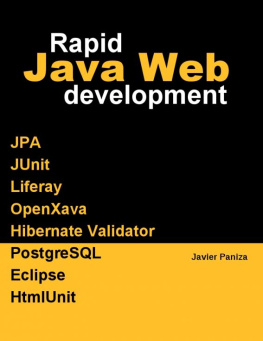
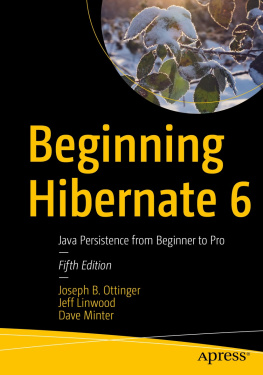
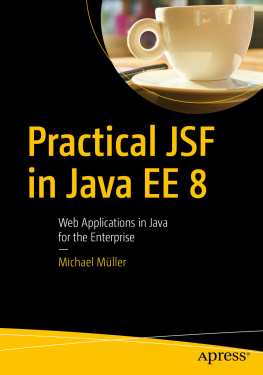
![Michael Müller [Michael Müller] - Practical JSF in Java EE 8 : Web Applications ​in Java for the Enterprise](/uploads/posts/book/124065/thumbs/michael-mg-ller-michael-mg-ller-practical.jpg)
![Vishal Layka [Vishal Layka] - Learn Java for Web Development: Modern Java Web Development](/uploads/posts/book/119395/thumbs/vishal-layka-vishal-layka-learn-java-for-web.jpg)
![Ram Kulkarni [Ram Kulkarni] - Java EE 8 Development with Eclipse](/uploads/posts/book/119355/thumbs/ram-kulkarni-ram-kulkarni-java-ee-8-development.jpg)

